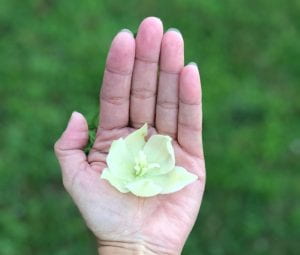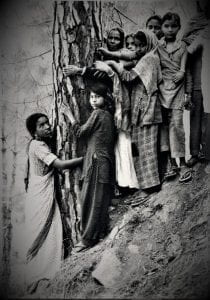
Photo by Rose Costa
From an ecofeminism perspective, this image of a female hand holding a small delicate flower in its palm may be interpreted as a symbol of the interconnectedness and interdependence between women and nature. The image suggests that women have a nurturing and protective relationship with the natural world, just as the hand is gently holding and caring for the flower. The delicate flower in the palm of the hand may also symbolize the fragility and vulnerability of both women and the environment, emphasizing the need for care and protection. From this perspective, the image may also be seen as a call to action in environmental activism and conservation efforts.
Ecofeminism, as described by Laura Hobgood-Oster in her 2002 essay Ecofeminism: Historic and International Evolution, “asserts that all forms of oppression are connected and that structures of oppression must be addressed in their totality” (1). That is, oppression of the natural world and of women by patriarchal power structures must be examined together or neither can be fully confronted. Although ecofeminism is a multidimensional movement that encompasses diverse perspectives and strategies, it is essentially rooted on the understanding that the oppression of women and the destruction of nature are connected and mutually reinforcing.
The main theory of ecofeminism is that the natural environment, often referred to as Mother Earth, is not just a passive backdrop to human activity but is a living entity that experiences “the tyranny of patriarchy along with women” (Hobgood-Oster, 2) and other marginalized groups. This idea is rooted in the belief that patriarchal systems of power and domination “through categorical or dualistic hierarchies … exist as an integral component of societal structuring and justification … [and] continue to serve as starting points to justify patriarchy” (Hobgood-Oster, 2-3). These systems which prioritize the interests of men and human society over those of women and the natural world, have led to the widespread degradation of the environment and the exploitation of non-human species. By recognizing and challenging the interrelation of these systems of oppression, ecofeminists hope to create a more equitable and sustainable society for all living beings.
The exploitation of natural resources in marginalized communities, often for the benefit of more privileged groups, is seen as both a form of environmental oppression and a manifestation of classism and racism. One example of ecofeminism in action is the Chipko Movement in India during the 1970s. The Chipko Movement was a grassroots effort led by rural women to protect their local forests from commercial logging. These women, mostly from the marginalized Himalayan communities, recognized that the destruction of their forests not only threatened their own livelihoods, but also the survival of the diverse species that lived there, they also saw that the logging companies were primarily controlled by wealthy, urban men who had little connection to or understanding of the needs of the local people.

Image by RightLivelihood.com
The women of the Chipko Movement took a non-violent approach by hugging the trees to prevent them from being cut down. They also organized protests, strikes, and boycotts against the logging companies and government officials who were complicit in the destruction of their forests. The movement gained widespread national and international attention, and ultimately led to the Indian government’s decision to ban logging in the region and to establish several national parks and wildlife sanctuaries in the area.
This movement demonstrates how ecofeminism can be a powerful force for environmental and social justice, as the women were not only fighting for the protection of their environment, but also for the rights of their communities and the rights of other species. They understood that the destruction of the forest was not only about the loss of resources but also about the loss of culture, traditions, and the loss of the sacredness of nature. The Chipko movement was a clear example of how the struggle for women’s rights, the rights of marginalized communities, and the rights of the environment are interconnected.
To learn more about the Chipko Movement visit: The Chipko Movement – Right Livelihood
